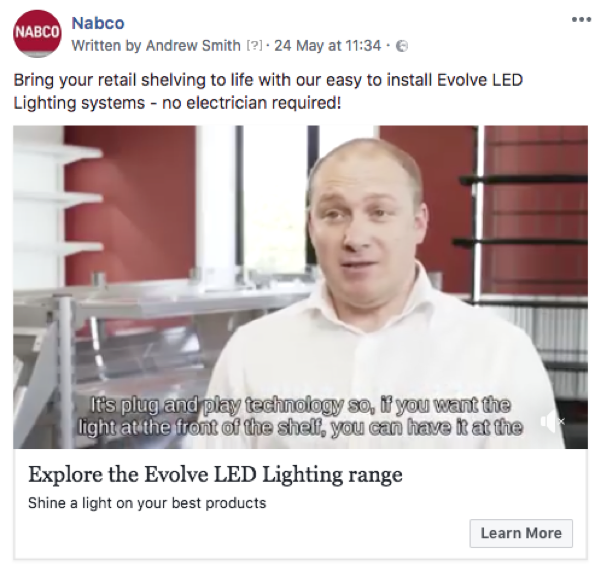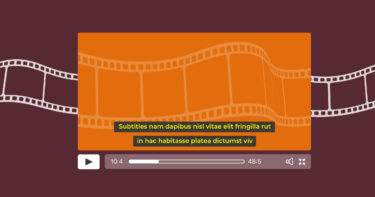I’ve been to my fair share of social media conferences and if I had a pound for every time I heard pleas from the speaker to “start including subtitles on video ads”, I’d be able to afford my own private island (or a maisonette in London Zone 6).
Did you know that according to Hootsuite, over 8 billion videos are viewed every day on Facebook? Of that, 85% of Facebook videos are being watched without sound? And that Facebook themselves revealed that adding captions to a video can increase engagement by up to 12%?
With all of these statistics pointing in the direction of closed caption inclusion, I decided to put the theories to the test and to see whether adding subtitles to a Facebook video ad was really worth the effort.
What did we do with the video?
First, I downloaded a short video from our client, Nabco. Their 59 second LED Lighting case study video succinctly detailed the benefits of their innovative product, making it the perfect test subject. After all, the recommended video length is around 1 minute.
To include subtitles as a proof of concept, I uploaded the video to EZGIF’s video subtitle generator. Ensuring the video is under a 30MB size limit, you can easily attach captions by manually entering the script and attaching start and stop time markers. The program also gives you the option to adjust the caption font size for readability.
A mere 15 minutes later and I had a fully captioned video that could be easily displayed on desktop and mobile devices.

With a £50 lifetime budget, I created the Facebook campaign, with the objective of driving traffic through the adverts ‘Learn More’ call to action. I also wanted the advert to build upon Nabco’s current Facebook audience and get in front of an audience who had never heard of the Nabco brand.
I took the advice of Guy Levine and decided to exclude all existing Facebook likers to ensure a new audience was viewing the advert in order to connect with users who had not already had any existing contact. With this technique, we could introduce the Nabco brand to the audience and hopefully warm up a potential lead, with the view to have them eventually convert to an enquiry.
In addition to the above, I was also conscious of mobile-first design. A survey from Statista revealed that 95% of Facebook users accessed the platform via smartphone. With this in mind, I ensured that the subtitles could be easily viewed on mobile devices by sending a test of the advert to my mobile device.
I also kept video playback in mind as another factor. At her BrightonSEO talk, Ashley Ward recommended always checking the ‘Only when Connected To Wifi’ option, available in the ‘Edit Placement’ section of a Facebook ad set. By targeting devices connected to Wifi, the advert would likely avoid buffering problems, thus preventing audience frustrations and keep them engaged with the advert.
With all of these numerous enhancements to the presentation of our video ads, I believed we had the recipe for a successful ad campaign.
Result 1: Captions and ad placement enhanced engagement levels
| May 2018 – LED Video | |
|---|---|
| Budget | £50.00 |
| Link Clicks | 228 |
| Cost Per Link Click | £0.22 |
| Reach | 5,692 |
| Impressions | 7,632 |
| Video Percentage Watched | 24.09 |
The advert went live on a Thursday afternoon and ran for 5 days and the results speak for themselves.
When using uncaptioned video for adverts we had run in the past, we had been reaching an average video percentage watched of 2 to 3%. Our captioned video reached a staggering 24.09%, with our audience watching 14 seconds of the video on average.
| May 2017 – Home Page Video | May 2018 – LED Video | |
|---|---|---|
| Budget | £250.00 | £50.00 |
| Video Percentage Watched | 2.17% | 24.09% |
| Video Watches @ 25% | £425.00 | £204.00 |
| Video Watches @ 50% | 198 | 140 |
| Video Watches @ 75% | 71 | 107 |
| Video Watches @ 95% | 53 | 51 |
| Video Watches @ 100% | 51 | 31 |
Nabco ran a video advert back in May 2017, without any subtitles. This video had a budget of £250. As you can see from the results, the advert suffered from audience drop off at a very early stage, most noticeably at the 75% of video watched stage, where the more recent campaign had more engaged viewers.
Arguably, the video playback must have played a part in keeping our audiences attention fixed to the video. We didn’t experience any significant drop off points. Without a doubt, if the May 2017 advert had captions supporting the video, it would have performed significantly better.
After the campaign ended, we caught up with the team at Nabco and were able to coordinate who made it to our landing page through Google Analytics UTM tracking. The team also revealed that a number of their enquiries had originated through social, with clients mentioning that they had seen their product range on Facebook.
Result 2: Adding captions actually encouraged users to turn audio on
| May 2017 – | Home Page Video | May 2018 – | LED Video | |
|---|---|---|---|---|
| Sound Description | Sound On | Sound Off | Sound On | Sound Off |
| Video Watches @ 25% | 11 | 414 | 179 | 25 |
| Video Watches @ 50% | 4 | 194 | 124 | 16 |
| Video Watches @ 75% | 1 | 70 | 99 | 8 |
| Video Watches @ 95% | 1 | 52 | 43 | 8 |
| Video Watches @ 100% | 2 | 49 | 27 | 4 |
Bizarrely enough, results from the May 2018 ad show that a higher proportion of the audience watched the video with sound on as opposed to without sound.
27 users watched 100% of the video ad with the sound turned on, with only 4 users watching the entire video with no sound at all.
I found this anomaly particularly interesting as research suggests that 80% of Facebook users react negatively when videos start to autoplay on Facebook without warning. When videos play sound out loud, it can increase the probability of the user scrolling away from the video or be leaving negative sentiment.
Result 3: Having a larger budget doesn’t guarantee better engagement
| May 2017 – Home Page Video | May 2018 – LED Video | |
|---|---|---|
| Budget | £250.00 | £50.00 |
| Link Clicks | 377 | 228 |
| Cost Per Link Click | £0.66 | £0.22 |
| Reach | 43, 358 | 5,692 |
| Impressions | 51,570 | 7,632 |
| Video Percentage Watched | 2.17% | 24.09 |
As well as the impact of adding subtitles to the video, I also monitored how well the audience targeting performed.
The May 2017 advert had 5 times the budget of the May 2018 advert, yet didn’t result in a like-for-like increase in the number of link clicks. The subtitled video ran at a CPC rate of £0.22, in comparison to the May 2017 video, which generated a CPC rate of £0.66.
Effective audience targeting combined with a video that enhanced the viewers experience promoted customer intrigue, which eventually led to them clicking our ‘Call to Action’ button or clicking on to our Facebook page for further info about the brand.
Key Takeaways
- Subtitles do work – plain and simple. Avoid being a late adopter and start adding subtitles to your case study videos. Try experimenting with Facebook’s video ad platform and ensure you are creating a bespoke piece of content that works without sound and is truly engaging.
- Try the Facebook A/B split test option and find out what your audience prefer to hear from you. The beauty of a Facebook video is that it can convey as much or as little of your brand’s message as possible. This can give you a bit more freedom with the ad copy and headline text. Give Ad A a long text copy and Ad B a short text copy and see which resonates better with your audience. The results from this can help you better refine your ad messaging for future campaigns, giving you an idea of your audience’s attention capacity.
- Ensure you have your Facebook pixel installed on your website and make sure it is triggering. You can begin filtering audiences depending on where they are within the sales funnel. Our video advert for Nabco was designed to target those at the start of the funnel by generating brand awareness. For our next advert, we can create a tailored audience using the pixel, segmenting our traffic into a new audience of potential converters. From here, we can target users who are in the next stage of the purchase funnel.
- Make sure your video ads are being served to devices connected to WiFi only. Our ultimate objective is to ensure we are keeping the audience engaged and by preventing that dreaded loading wheel, we can capture their attention for much longer.
- A larger ad budget will get you in front of a bigger audience, but correctly targeting your audience is essential to ensuring the budget isn’t going to waste. The higher the frequency an advert is shown to the same target audience, the more likely they are to negatively engage with the advert, including eventually hiding all future ads from your brand. Avoid overkill!
If you’d like to learn more about our success with Facebook Video Ads or how we can help enhance your social media campaigns, get in touch today!














